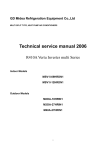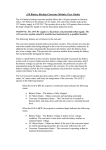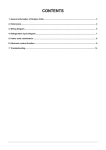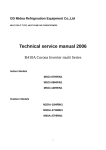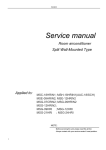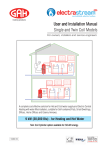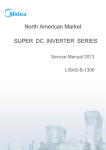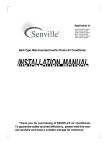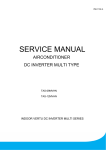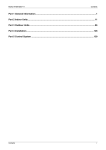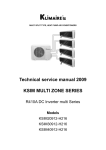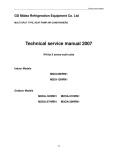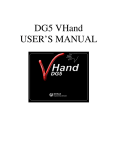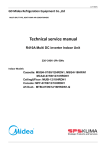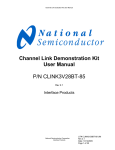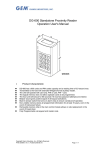Download Midea MSV1i-12HRDN1 User Guide Manual
Transcript
GD Midea Refrigeration Equipment Co.,Ltd MULTI SPLIT TYPE, HEAT PUMP AIR CONDITIONERS Technical service manual 2006 R410A Vertu Inverter multi Series Indoor Models MSV1I-09HRDN1 MSV1I-12HRDN1 Outdoor Models M2OA-18HRIN1 M3OA-27HRIN1 M40A-27HRIN1 1 Downloaded from AC-Manual.com Manuals 1. Product features 2. Dimensions 3. Refrigeration cycle diagram 4. Operation temperature limits 5. Indoor units combination 6. Wiring diagram 7. Wiring connection 8. Electric control functions 9. Troubleshooting Annex 1 Characteristic of temp. sensor Annex 2 Reference data 2 Downloaded from AC-Manual.com Manuals 1 Product Features 1.1 Powerful at cooling/heating. 1.2 Low voltage start-up function. 1.3 Anti-icing function at cooling mode. 1.4 Anti-cold air function at heating mode. 1.5 Auto-defrosting. 1.6 Outdoor electric current protection 1.7 Temperature protection of the outdoor compressor top. 1.8 Error self diagnosis function. 1.9 Free connection between indoor and outdoor unit 3 Downloaded from AC-Manual.com Manuals 2 Dimensions 2.1 Indoor unit Dimension W H D 9K 795 270 165 12K 845 286 165 Mode 2.2 Outdoor unit a) Outdoor unit M2OA-18HRIN1& M3OA-27HRIN1 Downloaded from AC-Manual.com Manuals 335 845 b) Outdoor unit M4OA-27HRIN1 5 Downloaded from AC-Manual.com Manuals 3 Refrigeration Cycle Diagram 3.1 Refrigeration circuit drawing of inverter quadplex type Capillary A EXV A Capillary B EXV B Capillary C EXV C Liquid valve A Axial flow fan Filter A Coil temp. sensor 4-way valve Check Valve Liquid valve B Filter B Liquid valve C Filter C Capillary C EXV C Liquid valve D Filter C Compressor Indoor pipe out temp. seneor A Gas valve A Indoor pipe out temp. seneor B Gas valve B Indoor pipe out temp. seneor C Gas valve C Indoor pipe out temp. seneor D Gas valve D Evaporator Condenser Main Capillary Cross flow fan Auxiliary Capillary Exhaust temp. sensor Indoor Unit Outdoor Unit 3.2 Refrigeration circuit drawing of inverter trinary type Axial flow fan Condenser 4-way valve Coil temp. sensor EXV A Capillary B EXV B Liquid valve A Filter A Liquid valve B Filter B Check Valve Capillary C EXV C Liquid valve C Filter C Compressor Gas valve A Indoor pipe out temp. seneor B Gas valve B Indoor pipe out temp. seneor C Gas valve C Indoor Unit Outdoor Unit 6 Downloaded from AC-Manual.com Manuals Indoor pipe out temp. seneor A Evaporator Main Capillary Capillary A Cross flow fan Exhaust temp. sensor Auxiliary Capillary 3.2 Refrigeration circuit drawing of inverter binary type Axial flow fan EXVA Exhaust temp. sensor Main Capillary Auxiliary Capillary Filter A Liquid valve A Capillary A EXVB Filter B Capillary B Compressor Indoor pipe out temp. seneor A Gas valve A Indoor pipe out temp. seneor B Gas valve B Indoor Unit Outdoor Unit 4 Liquid valve B Operation Temperature Limits Cooling mode Heating mode Dry mode Indoor temperature Outdoor temperature Indoor temperature Outdoor temperature Indoor temperature Outdoor temperature 7 Downloaded from AC-Manual.com Manuals Evaporator 4-way valve Coil temp. sensor Cross flow fan Condenser Check Valve 17℃~32℃ 0℃~50℃ <=30 -15℃~33℃ 10℃~32℃ 0℃~50℃ 5 Indoor units combination 5.1 M2OA-18HRIN1 Indoor units can be combined by 7000Btu/h 9000 Btu/h 12000Btu/h 7000Btu/h+9000 Btu/h 7000Btu/h+12000Btu/h 9000Btu/h+9000 Btu/h 9000Btu/h+12000Btu/h 12000Btu/h+12000Btu/h 12000Btu/h+18000Btu/h 9000Btu/h+18000Btu/h 7000Btu/h+18000Btu/h 5.2 M3OA-27HRIN1 Indoor units can be combined by 7000Btu/h 9000 Btu/h 12000Btu/h 7000Btu/h+9000 Btu/h 7000Btu/h+12000Btu/h 9000Btu/h+9000 Btu/h 9000Btu/h+12000Btu/h 12000Btu/h+12000Btu/h 12000Btu/h+18000Btu/h 9000Btu/h+18000Btu/h 7000Btu/h+18000Btu/h 7000Btu/h*2+9000 Btu/h 7000Btu/h*2+12000 Btu/h 7000Btu/h*2+18000 Btu/h 7000Btu/h*3 9000Btu/h*2+7000 Btu/h 9000Btu/h*2+12000 Btu/h 9000Btu/h*3 12000Btu/h*2+7000 Btu/h 12000Btu/h*2+9000 Btu/h 12000Btu/h+7000Btu/h+9000Btu/h 5.3 M4OA-27HRIN1 Indoor units can be combined by 7000Btu/h 9000 Btu/h 12000Btu/h 8 Downloaded from AC-Manual.com Manuals 7000Btu/h+9000 Btu/h 7000Btu/h+12000Btu/h 9000Btu/h+9000 Btu/h 9000Btu/h+12000Btu/h 12000Btu/h+12000Btu/h 12000Btu/h+18000Btu/h 9000Btu/h+18000Btu/h 7000Btu/h+18000Btu/h 7000Btu/h*2+9000 Btu/h 7000Btu/h*2+12000 Btu/h 7000Btu/h*2+18000 Btu/h 7000Btu/h*3 9000Btu/h*2+7000 Btu/h 9000Btu/h*2+12000 Btu/h 9000Btu/h*2+18000 Btu/h 9000Btu/h*3 12000Btu/h*2+7000 Btu/h 12000Btu/h*2+9000 Btu/h 12000Btu/h*3 7000Btu/h+9000Btu/h+12000Btu/h 7000Btu/h+9000Btu/h+18000Btu/h 9000Btu/h+9000Btu/h+18000Btu/h 7000Btu/h+12000Btu/h+18000Btu/h 9000Btu/h+12000Btu/h+18000Btu/h 7000Btu/h*2+9000 Btu/h*2 7000Btu/h*2+9000 Btu/h+12000 Btu/h 7000Btu/h*3+9000 Btu/h 7000Btu/h*3+12000 Btu/h 7000Btu/h*3+18000 Btu/h 7000Btu/h*4 9000Btu/h*2+7000 Btu/h+12000 Btu/h 9000Btu/h*3+7000 Btu/h 9000Btu/h*3+12000 Btu/h 97000Btu/h*4 Remark: 1. One, two, three or four indoor units can be connected according your need; 2. As 18000 Btu/h unit, just Cassette and duct are available. 3. There should be no more two duct indoor units and other indoor units should be all wall mounted in a system; 4. There should be no more one cassette and other indoor units should be all wall mounted in a system; 5. Cassette and duct can not be combined in a system; 6. When heating, capacity attenuate sharply if indoor unit capacity exceed too much. 9 Downloaded from AC-Manual.com Manuals 6. Wiring Diagram 6.1 Indoor unit 6.2 Outdoor unit M2OA-18HRIN1 10 Downloaded from AC-Manual.com Manuals 6.3 Outdoor unit M3OA-27HRIN1 11 Downloaded from AC-Manual.com Manuals 6.4 Outdoor unit M4OA-27HRIN1 12 Downloaded from AC-Manual.com Manuals 7 Wire connection 7.1 Connection wire specification Standard Cores Thickness(mm2) Wire cover length(mm) specification Connection wire between indoor 4 Neoprene 6000 1.0 unit and outdoor (L,N,S,Grounding) YZW300/500V unit Remark: The connection wire between indoor unit and outdoor unit is standard. And it is packaged in the indoor unit. 7.2 Connection wire drawing Heat retractile pipe Tight cincture C5A 21*9*37 120 magnetism cycle Wire connection terminal 2 Neoprene YZW300/500V Plug Grouding terminal Grounding 1.0mm2 1.0mm2 S N L 20±10 13 Downloaded from AC-Manual.com Manuals 8 Electronic control function 8.1 Protection 1. 3 minutes delay at restart for compressor. 2. Temperature protection of compressor top, compressor stops when the temp. of top of compressor is more than 120℃, compressor runs when the temp. of top of compressor is less than 105℃. 3. When AC voltage ≥ 270V for 30 seconds, Outdoor Unit stops operation and alarms. When AC voltage ≤ 260V for 30 seconds, outdoor unit resumes operation. 4. Inverter module protection, Inverter module Protection itself has a protection function against current, voltage and temperature. 5. Sensor protection at open circuit and breaking disconnection. 6. Fan Speed is out of control. When Indoor Fan Speed is too high (higher than High Fan+300RPM) or too low (lower than 400RPM), the unit stops and LED displays failure information and can’t return to normal operation automatically. 7. Cross Zero signal error warning. If there is no Cross Zero signals in 4 minutes, the unit stops and LED displays failure information and can’t return to normal operation automatically. 8. Current protection: When the current is more than 25A, the compressor stops. 9. Outdoor condenser high temperature protection: Under cooling mode, if T3>65℃ for 3 minutes, the compressor will stop. When T3<52℃, the protection is not valid. 10. Outdoor low temperature protection: If the outdoor temperature is lower than -15℃ for 1hour, the compressor and fan motor will stop. If the outdoor temperature is higher than -12℃ for 10 minutes and the compressor stops operation for 1h, or the outdoor temperature is higher than 5℃ for 10 minutes, then restart and enter into the prior operation mode. 11. Compressor pre-heating function: When the outdoor temperature is lower than 3℃ and the compressor stops operation for more than 3 hours, or the outdoor temperature is lower than 3℃ and the power is just put on, the compressor enters into pre-heating condition. When outdoor temp. is more than 5℃ or user operate it, pre-heating condition will finish. 8.2 Operating mode 8.2.1 Cooling mode 1.Indoor fan keeps running, fan speed can be set in high/mid/low/ Auto: 2.Auto fan at cooling mode: (T=Indoor Temp.-Setting Temp.) Condition Room temp. up Room temp. down Indoor fan speed T<1.5℃ Low 1.5℃<T<4℃ Mid. T>4℃ High T> 3℃ High 1℃<T<3℃ Mid. T<1℃ Low 3.Anti-freezing control to indoor evaporator at cooling mode( T: evaporator temp. ) 14 Downloaded from AC-Manual.com Manuals Evaporator Temp. Compressor T< 4℃ Off T > 8℃ On 8.2.2 Dehumidifying mode 1.The indoor fan is fixed in low speed 2. Low room temperature protection: When room temperature decreases to below 10 ℃ , indoor fan stop, when room temperature restores to over 12℃, indoor fan start. 3. At dehumidifying mode, the anti-freezing function of the indoor heat exchanger is the same as that of cooling mode. 8.2.3 Heating mode 1. Indoor Fan actions at heating mode Indoor Fan can be set at HIGH/MID/LOW/AUTO by using a remote controller, but Anti-cold wind function prevails. Anti-cold wind control function at heating mode Condition Indoor fan speed T= Indoor exchanger temp. Indoor exchanger temp. T<34℃ Off up 34℃<T<37℃ Breeze 37℃<T<44℃ Low speed T> 44℃ Setting fan speed Indoor exchanger temp. T> 38℃ Setting fan speed down 33℃<T<38℃ Low speed 24℃<T<33℃ Breeze T<24℃ Off Auto wind at heating mode Room temp. up Room temp. down Condition T=Indoor Temp.-Setting Temp. T<1.5℃ 1.5℃<T<2.5℃ T>2.5℃ T<1.0℃ 1.0℃<T<2.0℃ T>2.0℃ 15 Downloaded from AC-Manual.com Manuals Indoor fan speed High Mid. Low High Mid. Low Indoor evaporator high-temperature protection at heating mode Condition Compressor T= Indoor exchanger temp. T<48℃ On 53℃<T<63℃ Decrease frequency of compressor T>63℃ Off 8.2.4 Defrost operation 1. Defrosting condition: The temperature of outdoor heat exchanger remains consecutively lower than -2°c for more than 40 minutes, 2. Ending condition of defrosting If one of following conditions is satisfied, end the defrosting and turn into heating mode: a. The defrost time has reached to 10 minutes. b. When the temperature of outdoor heat exchanger rises up to 15°C. 3. Defrosting Actions: a. Compressor runs. b. 4 way valve switches off, c. Outdoor fan switches off d. Indoor fan running according to anti-cold wind function in heating mode. 4. Automatic operation mode The air conditioner automatically selects one of the following operation modes: cooling, heating or fan only according to the temp. difference between room temp. (TA) and set temp. (TS). TA—TS Operation mode TA—TS>2℃ Cooling -1℃≤TA-TS≤+2℃ Fan-only TA-TS<-1℃ Heating (air-only for cooling only type) 8.3 Mode conflict The indoor units can not work cooling mode and heating at same time. Heating mode has a priority. 8.3.1Definition Cooling mode Heating Mode Fan Off Cooling mode No Yes No No Heating Mode Yes No Yes No Fan No Yes No No Off No No No No No: No mode conflict; Yes: Mode conflict 8.3.2 Unit action • In case of one Indoor unit working in cooling mode or fan mode, and another indoor unit is set to heating mode, the indoor unit working in cooling mode or fan mode will 16 Downloaded from AC-Manual.com Manuals • change to stand by. The outdoor unit will work in heating mode. In case of one Indoor unit working in heating mode, and another indoor unit is set to cooling mode or fan mode, the indoor unit setting to cooling mode or fan mode will change to stand by. 8.4 Manual switch Mode changes when push this button. Cooing modeÆ Auto modeÆUnit offÆ Cooing mode At Cooing mode, after 30 minutes cooling operation whose fan speed is set as low, the A/C operates with a setting temp. of 24℃. At auto mode, the A/C operates with a set temp. of 24℃ 8.5 Timer Function 1. The maximum length of timer is 24 hours and the minimum resolving power is 15 minutes. 2. Timer on: first turn off the A/C, the A/C will be automatically on at the set time. 3. Timer off: first turn on the A/C, the A/C will be automatically off at the set time 4. Timer on/off function( on time is earlier than off time): first turn off the A/C, it will be automatically on at set time, and later be off at the set time, then unit turns on at set time. 5. Timer off/on function( off time is earlier than on time): first turn on the A/C, it will be automatically off at set time, and later be on at the set time, then unit turns off at set time. 8.6 Sleep mode 8.6.1It is available at cooling, heating or auto mode. 8.6.2Cooling: The set temperature rise 1℃ per hour. Two hours later, the set temperature will maintain as a constant and the fan speed is kept at low speed. 8.6.3Heating: The set temperature decrease 1℃ per hour. Two hours later, the set temperature will maintain as a constant and the air circulation is kept at low speed (Cold air proof function takes precedence over all). 8.6.4 Auto: The Sleep Mode running function operates in accordance with selected running mode by auto mode. 8.6.5After 7 hours, unit cancels this mode automatically. J2 On On Off Off J3 On Off On Off Stop time 7 hours 8 hours 6 hours 7 hours 17 Downloaded from AC-Manual.com Manuals 8.7 Auto restart function In case of a sudden power failure, this function automatically sets the unit to previous settings before the power failure when power returns. 8.8 Capacity test frequency locked. When test the cooling capacity, the frequency can be locked at Rated Frequency by following the below: 1. Set the indoor temp. to 17℃ and high speed; 2. Push the outdoor check button for 5 seconds, then its frequency can be fixed at Rated Frequency. After the test is over, turn off the indoor to exit. When test the heating capacity, the frequency can be locked at 85Hz by following the below: 1. Set the indoor temp. to 30℃ and high speed; 2. Push the outdoor check button for 5 seconds, then its frequency can be fixed at Rated Frequency. After the test is over, turn off the indoor to exit. 8.9 Indoor unit indicator displayer 8.9.1 OPERATION indicator This indicator flashes after power is on and illuminates when the unit is in operation. 8.9.2 AUTO indicator This indicator illuminates when the air conditioner is in AUTO operation. 8.9.3 TIMER indicator This indicator illuminates when TIMER is set ON/OFF. 8.9.4 CLEAN AIR indication lamp Lights up when CLEAN AIR feature is activated and Ionizer can generate abundant anions to fill the room with refreshing and natural air. 8.9.5 PRE.-DEF. Indicator (For Cooling & Heating models only) This indicator illuminates when the air conditioner starts defrosting automatically or when the warm air control feature is activated in heating mode. 8.9.6 TURBO indication lamp Lights up when select TURBO function on cooling operation or on heating operation. 8.9.7 FREQUENCY indicator This indicator appears only when the compressor is in operation and indicates the current operating frequency. 8.9.8 TEMPERATURE indicator Usually it displays the temperature settings. When change the setting temperature, this indicator begins to flash, and stops 20 seconds later. It displays the room temperature when the air conditioner is in FAN only operation. When the unit stops operation, it returns to original factory settings. 18 Downloaded from AC-Manual.com Manuals Displays the malfunction code or protection code. 8.9.9 FAN SPEED indication lamp Displays the selected fan speed: AUTO(nothing) and three and HIGH. fan speed levels: LOW, MED 8.10 Outdoor unit LED display function: 1. When stand-by it display number of indoor unit online; 2. When operation it display frequency of outdoor unit; 3. When defrost it display “df”; 4. When a protection or error occurred, it displays error code or protection code. 8.11 Check function: There is a check button on outdoor pcb. When push this button, the outdoor LED can display in sequence: Capacity demand→Running mode →revised capacity → fan state →No.1 evaporator pipe temp. →No.2 evaporator pipe temp.→No.3 evaporator pipe temp.→No.4 evaporator pipe temp.→outdoor pipe temp. → Outdoor temp. →discharge gas temp.→current of outdoor unit → No. 1 opening degree of electronic expansion valve → No. 2 opening degree of EXV → No. 3 opening degree of EXV→No. 4 opening degree of EXV→indoor unit number→last protection/error code→capacity demand(cycle) Explanation for the some display content: 1. Running mode: Display Corresponding mode 0 Off 1 Cooling mode 2 Heating mode 2. Fan state: Display Corresponding mode 0 Off 1 Low fan 2 High fan 3. Opening degree of EXV: Opening degree equals the display data times 8; 4. Number of indoor unit The indoor unit that can communicate with outdoor unit normally. 19 Downloaded from AC-Manual.com Manuals 8.12 Outdoor fan speed control There is one fan with two-speed, the fan speed is controlled according ambient temp. After the compressor stop, 30 seconds later the fan stops. When cooling: Ambient temp.rise Ambient temp.decline > 27 High speed <27 Low speed >25 High speed <25 Low speed > 14 Low speed <14 High speed >12 Low speed <12 High speed When heating: Ambient temp.rise Ambient temp.decline 8.13 Oil return function If operation frequency is lower than 54Hz in 2 hours consecutively, it will be increased to 62Hz for 3 minutes. Then it recovers to the former operation frequency. 20 Downloaded from AC-Manual.com Manuals 9 Troubleshooting for outdoor unit 9.1 Safety Because of there are capacitors in PCB and relative circuit in outdoor unit, even shut down the power supply, electricity power still are kept in capacitors, do not forget to discharge the electricity power in capacitor. The value of resistance is about 1500 ohm to 2000 ohm Resistance The voltage in P3 and P4 in outdoor PCB is high voltage about 310V The voltage in P5 and P6 in outdoor PCB is high voltage about 310V 21 Downloaded from AC-Manual.com Manuals 9.2 LED error code display for indoor unit Display LED STATUS E0 EEPROM error E1 Indoor and outdoor unit communication error E2 Zero-crossing examination error E3 Fan speed beyond control E5 Outdoor units temp. sensor or connector of temp. sensor is defective E6 Indoor units temp. sensor or connector of temp. sensor is defective P0 Inverter module protection P1 Outdoor unit voltage protection P2 Compressor top temperature protection P3 Outdoor low temp. protection P4 Inverter compressor drive protection P5 Mode conflict protection 9.3 LED error code display for outdoor unit Display Explanation E0 EEPROM error E1 No 1 Indoor units pipe temp. sensor or connector of pipe temp. sensor is defective E2 No 2 Indoor units pipe temp. sensor or connector of pipe temp. sensor is defective E3 No 3 Indoor units pipe temp. sensor or connector of pipe temp. sensor is defective E4 Outdoor temp. sensor or connector of temp. sensor is defective E5 Compressor voltage protection E6 No 4 Indoor units pipe temp. sensor or connector of pipe temp. sensor is defective E7 Outdoor inverter communication error P0 Compressor top protection against temperature P1 High pressure protection (reserve) P2 Low pressure protection (reserve) P3 Compressor current protection P4 Inverter module protection P5 Outdoor low temp. protection P6 Condenser high-temperature protection 22 Downloaded from AC-Manual.com Manuals 9.3 Trouble shooting Display E0 LED STATUS EEPROM error Temporarily turn off the power supply and turn it on again after 1 minute Does the trouble occur again? Yes Replace the indoor PCB 23 Downloaded from AC-Manual.com Manuals Display LED STATUS E1 No 1 Indoor units pipe temp. sensor or connector of pipe temp. sensor is defective Is connection to connector of pipe temp. sensor good? No Yes Repair connector Check the resistance of the temp. sensor according to Annex 1 Replace the sensor Display LED STATUS E2 No 2 Indoor units pipe temp. sensor or connector of pipe temp. sensor is defective Is connection to connector of pipe temp. sensor good? No Yes Repair connector Check the resistance of the temp. sensor according to Annex 1 Replace the sensor Display LED STATUS E3 No 3 Indoor units pipe temp. sensor or connector of pipe temp. sensor is defective Is connection to connector of pipe temp. sensor good? No Yes Repair connector Check the resistance of the temp. sensor according to Annex 1 Replace the sensor 24 Downloaded from AC-Manual.com Manuals Display LED STATUS E4 Outdoor units temp. sensor or connector of temp. sensor is defective Is connection to connector of pipe temp. sensor good? No Yes Repair connector Check the resistance of the temp. sensor according to Annex 1 Replace the sensor Display E5 LED STATUS Compressor voltage protection Check the voltage of power supply, if the voltage is about 220V, turn off the power supply to indoor unit and turn it on again after 1 minute Does the trouble occur again? Yes Check the voltage of secondary of T3 transformer in outdoor power board, is this voltage 12-14V (AC) No Replace the outdoor power board 25 Downloaded from AC-Manual.com Manuals Display E7 LED STATUS Indoor / outdoor units communication protection Is the LED in outdoor main PCB light? Yes Check the signal wires between outdoor No PCB’s, is it connected good. 1.Is the +5 voltage in outdoor main board? No Power Board: CN1, Red wire and yellow (GND) Outdoor main PCB: CZ1 2.Is the +12 voltage in outdoor main board? Power Board: CN1, Purple wire and yellow (GND) Inverter module defective. Rectifier circuit is bad connection or defective when the voltage in outdoor is abnormal . P3 and P4: 310V(DC); P5 and P6: 310V(DC); Yes Check the PC521,PC851 (at Outdoor power PCB) No Normally: Input voltage: <5V, changeable Output voltage:<24V, changeable Outdoor power PCB is defective. Yes Check the PC817,PC851 (at Indoor main PCB and outdoor main board) Normally: Input voltage: <5V, changeable Output voltage:<24V, changeable Indoor PCB or outdoor main PCB are defective. 26 Downloaded from AC-Manual.com Manuals Display LED STATUS P0 Compressor top protection against temperature Off: 120℃; On: 105℃ No Does compressor operate? Yes Is refrigerant circulation volume normal? Is protector on the top of compressor normal? Normally the resistance of the protector is 0 ohm. No No Gas charging Is abnormality the same after gas charging? Yes Check the outdoor main PCB. No Refrigerant system (such as clogging of capillary, clogging of pipe etc) 27 Downloaded from AC-Manual.com Manuals Replace protector Display LED STATUS P3 Compressor current protection Check the resistance of compressor, normally No U and V is 0.6 ohm U and W is 0.6 ohm V and W is 0.6 ohm The compressor is defective No Turn one indoor unit only, Does the compressor start after 3 minutes? Yes No The compressor is defective Does the trouble occur again after compressor running some time? Yes Check the refrigerant circulation volume and pressure If refrigerant circulation volume and pressure is OK, change the outdoor main PCB. 28 Downloaded from AC-Manual.com Manuals Display LED STATUS P4 Inverter module protection Check the connectors CN12, CN7, CN1 in outdoor PCBs Is connection to connector good? Yes No Are the wires to compressor right? Repair connector Yes Check the outdoor inverter module. Is it breakdown between P-N,P-U,P-V;N-W,N-U,N-V At inverter module Normally, P-N: ~1.0MΏ P-U: ~2.0MΏ P-V: ~2.0MΏ P-W: ~2.0MΏ N-W: ~1.0MΏ N-U: ~1.0MΏ N-V: ~1.0MΏ Yes Inverter module is defective No Check compressor 1.Turn on the unit in cooling or heating in different season, use a frequency meter to test the frequency in one of the three wires to compressor, if there is frequency in wires, but compressor do not run, the compressor is defective. 2.Between U,V,W three terminals , the resistance is about 0.6 Ώ. 29 Downloaded from AC-Manual.com Manuals Display P5 LED STATUS Outdoor low temp. protection This is optional, factory standard unit does not have this function. Unit stops when outdoor temp. is lower than -15°C and lasting time more than 60 minutes, and unit runs again when outdoor temp. more than -12°C. Is the outdoor temp. lower than -15°C? No Is the outdoor temp sensor right according to the annex 1 No Yes Replace the outdoor main board Display P6 Replace the outdoor temp sensor LED STATUS Condenser high-temperature protection When outdoor pipe temp. is more than pipe temp. is less than 52°C. 65°C, the unit will stop, and unit runs again when outdoor Is the outdoor pipe temp. more than 65°C ? No Is the outdoor pipe temp sensor right according to the annex 1 Yes Replace the outdoor main board No Replace the outdoor pipe temp sensor 30 Downloaded from AC-Manual.com Manuals Annex 1 Characteristic of temp. sensor Temp.℃ Resistance KΩ Temp.℃ Resistance KΩ Temp.℃ Resistance KΩ -10 62.2756 17 14.6181 44 4.3874 -9 58.7079 18 13.918 45 4.2126 -8 56.3694 19 13.2631 46 4.0459 -7 52.2438 20 12.6431 47 3.8867 -6 49.3161 21 12.0561 48 3.7348 -5 46.5725 22 11.5 49 3.5896 -4 44 23 10.9731 50 3.451 -3 41.5878 24 10.4736 51 3.3185 -2 39.8239 25 10 52 3.1918 -1 37.1988 26 9.5507 53 3.0707 0 35.2024 27 9.1245 54 2.959 1 33.3269 28 8.7198 55 2.8442 2 31.5635 29 8.3357 56 2.7382 3 29.9058 30 7.9708 57 2.6368 4 28.3459 31 7.6241 58 2.5397 5 26.8778 32 7.2946 59 2.4468 6 25.4954 33 6.9814 60 2.3577 7 24.1932 34 6.6835 61 2.2725 8 22.5662 35 6.4002 62 2.1907 9 21.8094 36 6.1306 63 2.1124 10 20.7184 37 5.8736 64 2.0373 11 19.6891 38 5.6296 65 1.9653 12 18.7177 39 5.3969 66 1.8963 13 17.8005 40 5.1752 67 1.830 14 16.9341 41 4.9639 68 1.7665 15 16.1156 42 4.7625 69 1.7055 16 15.3418 43 4.5705 70 1.6469 31 Downloaded from AC-Manual.com Manuals Annex 2 1. Reference voltage data: a) Rectifier : Input :220-230V(AC), output :310V(DC) Normally In power board: P3 and P4: 310V(DC) P5 and P6: 310V(DC) b) Inverter module: U,V, W 3ph. Result U-V 60-150V(AC) U-W 60-150V(AC) V-W 60-150V(AC) P-N DC 310V c) Photo-couple PC817, PC851: Control side <+5V, AC side :< 24V(AC) d) S terminal and N: changeable from 0-24V 2. Check the Diode Bridge component ( In wiring diagram, rectifier) Remark: If this part is abnormal, the LED will not light. ~ + - ~ Result Multi-meter + ~ ~ - _ + ~ ~ Forward Resistance Backward Resistance Infinite Infinite ~500 ohm Infinite ~500 ohm Infinite 32 Downloaded from AC-Manual.com Manuals
































